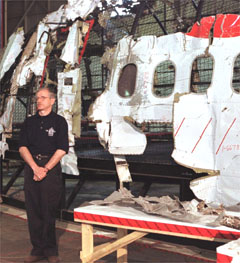Families hope for
answers in final report of Swissair Flight 111
crash
By ALISON
AULD
 |
|
In his progress report, Vic Gerden,
lead investigator into the crash of Swissair Flight 111
off Peggy's Cove, N.S., Sept. 2, 1998, said work has
almost ended in hangar at Shearwater, N.S., where a
nine-metre front section of the plane has been
reconstructed from wreckage. (CPArchive/Andrew
Vaughan) |
HALIFAX (CP) - For 4½ long years, Barbara Fetherolf has
searched for an answer to why her daughter - a bright,
energetic 16-year-old - stepped on to a plane operated by one
of the world's most respected airlines and never came home.
On Thursday, the Transportation Safety Board will release
its final report into the 1998 crash of Swissair Flight 111
off Nova Scotia, but Fetherolf fears she will be no closer to
the truth. "We're still in shock and we need to know why, why
she's dead," she said Wednesday from her home in Palm Beach,
Fla.
"My fear is that it will be a little like a laundry list of
contributing causes and no ignition source."
Tara Fetherolf was on her way to school in Switzerland when
the Swissair MD-11 plunged into the ocean, killing all 229
people on board.
Since the crash, the girl's mother has pressed governments
and safety agencies for a cause. She has kept files on
aviation issues and started a Web site to update family
members.
"It's ruined our lives, totally destroyed us, and we'd like
to know the answers - like anybody who has lost a child," said
Fetherolf.
Investigators know the jetliner was disabled after a fire
raced along its wiring, leading to a massive electrical
failure. But they haven't identified the cause of the fire and
likely won't in its report, to be made public in Halifax.
Sources say there will be 22 recommendations in the lengthy
document, some of which will deal with the plane's wiring.
It's also thought investigators will mention a controversial
inflight entertainment system that has come under scrutiny in
recent years.
Investigators combing through millions of pieces of debris
recovered 21 short-circuited electrical wires, including at
least seven that came from the system. A wire that shorts can
cause a spark or fire that could ignite other materials.
Some aviation experts believe the entertainment unit is key
to the fire.
Gerry Einarsson, an avionics specialist in Ottawa, said
recently that the system was hastily installed on the MD-11
and proper inspections weren't done to ensure it could operate
safely.
He called the system a "power-hungry monster" that demanded
an excessive amount of energy. Einarsson, a former Transport
Canada engineer, blames the American Federal Aviation
Administration in part for allegedly shirking its duties in
certifying the system - something he and others say the
Transportation Safety Board should address in its report.
The system, which allowed passengers to gamble, play video
games and watch movies, was found during test flights to raise
cabin temperatures and cause hard drives in passengers seats
to fail.
Ian Shaw, whose daughter Stephanie was also killed on
plane, also suspects the gaming unit for sparking the deadly
fire.
"My conviction is that the entertainment system, which
Swissair immediately took off all their flights after the
accident, was most probably the cause of the overheating of
the wiring," said Shaw, who moved to Nova Scotia from
Switzerland following the crash.
The safety board wouldn't comment on the details of the
report, but a spokesman said it will outline a chain of events
that led to the accident and that the findings are quite
"specific."
The report is also expected to briefly mention Kapton
wiring, a disputed insulation that has been banned in some
U.S. military aircraft because of its propensity to chafe,
crack or break down.
The safety board, which has spent about $60 million on the
investigation, recovered pieces of charred Kapton wiring in
the area where the fire was believed to have started in the
ceiling behind the pilots' seats.
Investigators found evidence of arcing, a phenomenon in
which the outer insulation is cracked or chafed and the wire
is exposed to another surface. Electrical sparks can escape
and set off a chain reaction that burns along the wire almost
like a fuse.
The FAA responded to the Swissair probe by ordering
operators to inspect cockpit wiring on all MD-11s.
Others are hoping the safety board demands changes to the
cumbersome checklist pilots go through when they encounter
smoke in the cockpit.
The Swissair pilots spent close to 10 minutes going through
a 208-step checklist after they detected smoke, eating up
valuable time some say should have been spent in diverting the
plane to the nearest airport.
The TSB issued a recommendation in 2000 that planes land
quickly in the event of smoke and that checklists be
streamlined. The board also recommended that metallized Mylar
blanket insulation be reduced or eliminated after finding it
helped feed the fire.

